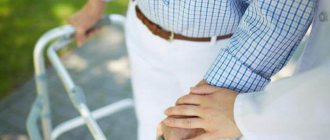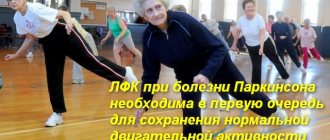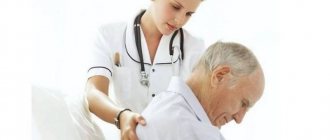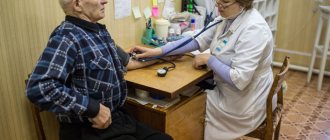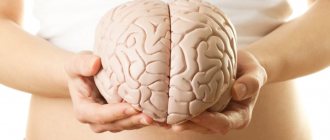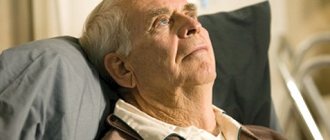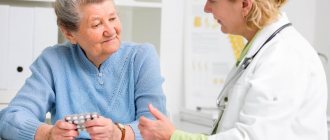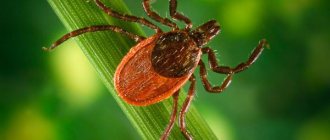14.01.2021
Over the years, a person accumulates more and more diseases. Many people approach old age with a whole “bouquet” of ailments, some of which cannot be cured or even predicted. This includes Parkinson's disease.
Its development does not depend on a person’s intellectual abilities. Even such gifted individuals as Salvador Dali suffered from Parkinsonism. Doctors still find it difficult to answer why it occurs. And yet there are methods to combat this serious disease.
Symptoms of the disease
Parkinsonism is a chronic disease of the central nervous system. The British James Parkinson described in detail and laid the foundations for its diagnosis. He found that the disease is the result of a lack of dopamine in the body, a neurotransmitter produced by the cerebral cortex.
The first signs of the problem usually appear after age 50. Parkinsonism is a neurodegenerative disease that progresses with age. The older a person gets, the more severe the symptoms become.
Signs of the disease:
- It becomes difficult for a person to navigate in space.
- There is tremor - trembling - of the limbs.
- There are difficulties with coordination.
- The patient's movements gradually become slower.
- In older people, the disease can take two forms. In the primary case, we are talking about Parkinson's disease itself, caused by heredity. The secondary form occurs against the background of worsening other diseases (Parkinson's syndrome).
The disease can be recognized in an elderly person by the following symptoms:
- Tremor. First, the patient's head begins to sway periodically. Then the trembling moves to the lower lip, arms, legs. Tremor is especially noticeable when a person does not move or is at rest. It becomes difficult for the patient to hold even light objects in his hands.
- Slowness of movements (in medical terminology - hypokinesia). Over time, a person suffering from Parkinson's seems to slow down. The range of movements of his arms and legs is significantly reduced. This also affects facial expressions.
- Rigidity. Elderly patients with Parkinsonism lose muscle tone. Often the degenerative process also affects the joints.
- Loss of sense of balance. Loss of orientation, instability, and frequent falls are the sad companions of Parkinson's disease.
There are several forms of the disease. In 40% of cases, doctors diagnose the trembling-rigid form, the most striking sign of which is tremor. 30% of patients suffer from slowness of movement. Trembling of the limbs is rare.
In 20%, a rigid-trembling form of the disease is diagnosed. With it, patients experience difficulties with coordination. In other cases, a trembling or akinetic form is observed. With the first, patients suffer from muscle tone, facial expressions, and severe tremor. With the second, the symptoms are almost invisible.
Morbidity statistics
In terms of frequency of development among neurodegenerative pathologies, PD ranks second after Alzheimer's disease. According to WHO, the disease is quite widespread: in total, there are more than 6 million people in the world with such a complex diagnosis. The incidence rate in Russia corresponds to 140-160 cases per 100 thousand population. At the same time, from year to year a steady increase can be seen in the spread of pathology even among young people aged 30-40 years. According to statistics, every 10th patient is under 40 years of age. If the onset of PD occurs any year before the age of 40, it is called juvenile parkinsonism.
Based on the information provided by different authors, up to 55 years of age the morbidity risks average 0.5%, from 55-74 years old - 1.5%, 75-85 years old - 2.5-3%, over 85 years old - 4-4 ,5%. The most vulnerable group of people to the disease are men. Disability, as a rule, occurs 3-5 years after the manifestation of symptoms. The average survival rate is 15 years. Parkinson's disease is one of the diseases with relatively low mortality rates. The causes of death are mainly complications after a fall, lung infections, pulmonary embolism, and infectious pathogenesis of the urinary tract.
Signs on MRI.
Causes of the disease
There are 3 main provoking factors:
1. Changes in cells.
Human motor activity is completely subordinated to the work of the brain. It is primarily influenced by the neurotransmitter dopamine. The less of it there is in the body - and with age, the production of dopamine decreases - the worse the body coordinates its actions.
A decrease in physical activity is observed in almost all older people. However, in citizens who are not susceptible to Parkinson's disease, it begins much later. In sick people, symptoms appear early and get worse every year.
The number of dopamine-containing cells in them decreases sharply.
This process develops rapidly, gradually leading a person to complete helplessness and disability. 2. Heredity.
Parkinson's disease is a “gift” from our ancestors.
If the parents had it, then the offspring are twice as likely to encounter the same problems in old age. The tendency to degenerative processes of the central nervous system is inherent in genes. 3. The influence of negative factors.
The development of the disease in older people is also due to the fact that the areas of the brain that produce dopamine are very sensitive to negative factors. Parkinson's disease can be triggered by:
- encephalopathy;
- taking antipsychotics and other drugs used in psychiatry;
- heart attack;
- cerebral atherosclerosis;
- encephalitis;
- neoplasms in brain tissue;
- severe head injuries;
- poisoning with chemicals and drugs, alcohol, carbon monoxide.
If the disease develops against the background of these factors, then they speak of secondary parkinsonism. Whatever the reasons, the disease always greatly complicates the life of the elderly. Due to the fact that a person cannot move freely, he becomes less socially active. Isolation and loneliness also have a negative impact on mental health.
Depression and limited movement make a person vulnerable to various illnesses. Patients with Parkinson's are prone to infectious and viral diseases, and due to poor coordination they also regularly suffer injuries. Naturally, a person with such a list of problems needs constant help.
Complications
Restriction of muscle function in Parkinson's disease inevitably leads to a decrease in the intensity of blood flow and a decrease in the level of metabolism. Already in the middle stages of the development of the disease, the risk of blood clots and the development of dangerous conditions increases significantly:
- ischemic or hemorrhagic stroke;
- myocardial infarction, angina pectoris, heart failure;
- pulmonary embolism.
Bedridden patients often face severe complications associated with a recumbent position:
- congestive pneumonia;
- aspiration pneumonia (due to impaired swallowing, food enters the respiratory tract);
- bedsore infection and sepsis.
Most patients experience apathy and severe depression, which lead to suicidal thoughts. Some patients carry out plans and commit suicide.
Correctly selected treatment significantly reduces the risk of complications, which is why it is important to consult a doctor in a timely manner.
Manifestations of Parkinson's disease
There are 2 types of signs. The first includes all the symptoms that were described earlier: hypokinesia, tremor, etc. Decreased motor activity is one of the most severe “companions” of the disease.
In a healthy person, the urge to do something is immediately reinforced by the readiness of the muscles. The vast majority of movements - walking, running, etc. - are performed involuntarily, immediately, without any prior preparation. A healthy person walks without thinking about the fact that he needs to lift his leg, move it to a new place and lower it.
The patient’s muscles poorly perceive nerve impulses, so a fairly noticeable period of time passes between the impulse and the action itself. Parkinson's disease affects walking, head and arm movements, even facial expressions. Facial muscles, having lost their tone, almost do not reflect the patient’s true emotions. From the outside it seems that he doesn’t care.
Decreased motor activity manifests itself in different ways. Sometimes patients simply freeze, and in rather uncomfortable positions. Handwriting also changes. An elderly person begins to write more slowly and does it with noticeable effort.
The patient’s muscles that flex and extend the limbs work simultaneously, so the body is constantly in good shape. The patient himself clearly feels this condition. People with developed disease are characterized by a certain posture: bowed head, pressed to the body, slightly bent arms.
Another characteristic sign is the so-called “rest tremor”. When the patient does not move, his head and arms make small rhythmic vibrations. If a person is worried, the trembling intensifies.
As the disease progresses, tremors affect the entire body. The eyes, legs, and lower lip may twitch. In the most severe form of parkinsonism, the tremors almost stop due to complete muscle rigidity.
These signs are closely intertwined with the inability to maintain balance. Because the muscles respond poorly to brain signals, a person cannot coordinate leg movements with body position. His gait becomes shuffling. Any shock can lead to a fall.
The described symptoms rarely occur as a single variant. Usually they are grouped, and the picture of Parkinson's disease manifests itself in full. Patients may also experience difficulty urinating/defecating, overactive sebaceous glands, drooling, and mental changes. Patients with Parkinsonism feel superfluous, get irritated over trifles, and are often grumpy and stingy.
Doctors often diagnose patients with this diagnosis as depression. They withdraw into themselves, try to avoid contact with others, and sometimes become fixated on one idea. There are problems with night sleep. Patients often get up at night, walk around the house, and cannot fall asleep.
The saddest thing is that mental abilities also suffer due to the disease. In the final stages, the elderly lose their memory and fall into senile dementia.
Stages of the disease
There are 5 stages of the disease, characterized by the following symptoms:
- I - slight rigidity and mild tremor;
- II - spread of tremor to the whole body;
- III - in addition to tremor and rigidity, there are also problems with coordination;
- IV - severe limitation of physical movements and disorientation;
- V - complete helplessness (the patient is forced to move in a wheelchair or lie down constantly).
The disease can develop slowly or rapidly. In some cases, older people remain at a certain stage for more than 5 years, in others, within 2 years they move to complete incapacity and helplessness. If the disease is not treated, life expectancy is reduced to 10 years.
Diagnostics
The first task of the doctor is to identify the causes of the disease. It is important to determine whether it is Parkinson's disease itself or whether the characteristic symptoms are a consequence of other ailments. Secondary parkinsonism can be caused by:
- increased blood pressure;
- head injuries;
- deposition of cholesterol on the walls of blood vessels;
- intoxication.
Diagnosis begins with an examination by a neurologist. Having prescribed therapy, the doctor constantly monitors the body’s response to medications. If the patient responds positively to medications designed specifically to treat Parkinson's disease, then the diagnosis is confirmed. Secondary parkinsonism is partially eliminated by other means.
In some cases, hardware diagnostics are performed using MRI and computed tomography.
Lifestyle during hallucinations
The patient’s further life depends on the reasons that caused the pathology. If there is a disease that cannot be treated, then you need to constantly maintain normal functioning with the help of medications. If hallucinations were caused by certain diseases, then after getting rid of them you need to engage in further prevention.
Important: you should also give up bad habits, lead a healthy lifestyle, and strengthen your immune system.
If hallucinations occur, you should consider going to the doctor. Especially if the pathology is protracted. The symptom may indicate deep brain damage. If you make a diagnosis in time and start treatment, you can get rid of intrusive images, sensations or sounds.
Treatment of Parkinson's disease
The complexity of the disease lies in its chronic course. There is no complete cure for Parkinson's disease. However, there are already medications that help the patient maintain physical and intellectual activity for quite a long time.
The therapy is complex. It includes taking special medications and vitamins, gymnastics, psychotherapy and massage sessions. The patient should not reduce physical activity. The longer the muscles are active, the later lethargy, loss of coordination and other symptoms will begin to appear.
Among the drugs used to treat Parkinson's are Mirapex, PC-Merz, etc. They contain substances that stop the death of dopamine-containing neurons. In combination with such medications, the patient is prescribed medications that relieve specific symptoms. For example, Levodopa is good for relieving tremors and other movement disorders.
Prevention
Prevention of Parkinson's disease includes:
- proper nutrition with a minimum amount of preservatives and artificial additives, a sufficient amount of vitamin D, omega-3, antioxidants;
- regular physical activity to prevent physical inactivity;
- adequate sleep of at least 8 hours a day, adherence to a work and rest schedule;
- minimizing stress and fatigue;
- quitting smoking and drinking alcohol;
- regular medical examinations, compliance with all doctor’s recommendations;
- timely contact a specialist if any suspicious symptoms appear.
Make an appointment
New in the treatment of parkinsonism
In recent decades, the disease has been very actively researched. Experiments are currently being conducted on stem cell treatment. Scientists have suggested that this technique can prolong the active phase of life of patients up to 15 years. The technology is currently being tested, and it is not yet known when it will become widespread.
Another area of research is related to the study of genes. Since parkinsonism is genetically determined, there is hope for identifying the chromosomes responsible for its development. Californian scientists have already found that the disease is caused by a genetic hereditary mutation.
Israeli specialists are testing ultrasound treatment methods. Its essence lies in the fact that with the help of ultrasound, the affected cells are destroyed, as a result of which the most serious symptoms of the disease disappear. This method is in many ways similar to surgery, but is more gentle on the patient.
Diet and rules of nutrition
Compliance with the diet and nutritional standards helps to significantly increase the effectiveness of drug therapy. First of all, medications should be taken half an hour before meals; then they will be better absorbed. The diet of Parkinson's patients should be fortified and varied. It is important to drink a lot of water (at least 1.5 liters per day).
Foods containing omega fatty acids are healthy: nuts, sea fish, vegetable oils. Protein products can be consumed no more than 3 times a week. There are practically no restrictions on plant and dairy foods. If the patient has difficulty swallowing, food should be prepared in grated or liquid form. There should be 4-5 meals a day (in small portions).
Physical activity that is feasible is of great importance:
- warm baths followed by kneading the limbs;
- anti-tremor exercises (rubbing your palms together at chest level);
- daily walks;
- exercises for the speech apparatus (reading aloud, recitation, etc.).
Caring for Parkinson's Patients
Not only physical help is extremely important, but also psychological support. The patient needs to be helped in all endeavors, but where possible, allowed to act on his own. You also need to communicate with him a lot so that his mental abilities do not fade.
It is important to ensure that the pensioner does not forget to take medications. The course of the disease and the general condition of the elderly depend on this. A lack of necessary substances manifests itself in:
- unexpected passion for shopping;
- unconditional increase in appetite;
- sudden mood swings;
- passion for hoarding;
- depression;
- aggressiveness.
Pay attention to this and report any suspicious changes to your doctor! The patient may need to adjust the dose of the drug.
When the disease has passed from the first stage to the second and subsequent ones, one cannot do without a wheelchair and other devices that make movement easier. All things that could injure him or cause other harm should be removed from the patient’s room. The bathroom should be equipped with special handrails. This will help avoid falls and injuries.
Classification of hallucinosis
Schizophrenia is a mental disorder that is accompanied by a complex set of symptoms. This condition manifests itself in a person as a violation of many areas of mental activity: emotional, volitional, mental, behavioral.
All manifestations of the disease are conventionally divided into 2 groups: positive and negative.
Hallucinations, along with delusions and thought disorders, are considered positive symptoms.
Hallucinosis should be distinguished from illusions. Illusion is the perception of a really existing object, but in a distorted form. For example, a mirage or reflection in distorting mirrors is based on illusory perception. Hallucination involves seeing an object that does not actually exist.
Many experts in their works divide hallucinatory visions in schizophrenia into true and pseudohallucinations.
True hallucinations are those that have the features of real objects. They have clear outlines and characteristics and fit harmoniously into the environment. It is difficult for the patient to believe that in reality they are not there and that other people do not see them. If these are inanimate objects, then the patient performs various manipulations with them. And if he sees living objects, people, then he talks to them.
Pseudohallucinations are distinguished by the absence of those features that are characteristic of real objects.
On the other hand, hallucinosis is divided depending on the analyzers;
- auditory;
- visual;
- olfactory;
- tactile;
- visceral.
